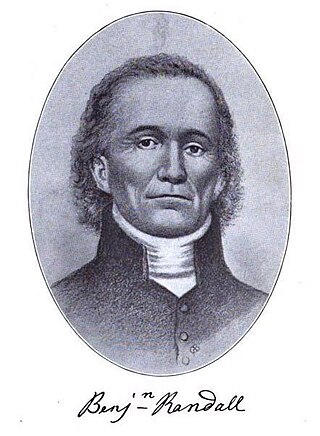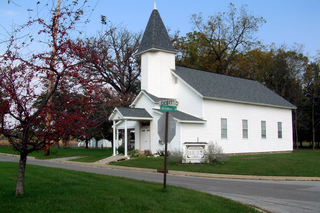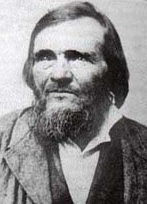The Independent Baptist Church of America traces its foundation back to a church organization by Swedish Free Baptist immigrants at Dassel, Minnesota in 1893. The body was initially known as the Scandinavian Baptist Church in America. In 1926 the denomination had 13 churches with 222 members. The name Independent Baptist Church of America was adopted in 1927. In 1936, there were 5 churches in Minnesota with 82 members. In 1956, there were 2 churches with 106 members, and down to 70 members in 1963. The church ceased to exist in the 1970s.
The National Primitive Baptist Convention, USA is a group of Black Primitive Baptists that has adopted progressive methods and policies not in keeping with the historical and theological background of Primitive Baptists in general. The Convention was organized in Huntsville, Alabama in 1907. These churches have adopted the use of instrumental music, Sunday Schools, revivals and church auxiliaries. The idea of a national convention is itself foreign to standard Primitive Baptist concepts. They still adhere the Calvinistic or Predestinarian teachings held by other Primitive Baptists, but in a more progressive mannaer and are similar to the black National Baptist Conventions. The NPBC churches continue with Primitive Baptist usage in retaining the observance of feet washing as an ordinance of the church, and in calling their ministers "elder." These churches are not in fellowship with the remaining "old school" white Primitive Baptists. Most of the National Primitive Baptist Convention churches are located in the southern United States.
Primitive Baptists – also known as Regular Baptists, Old School Baptists, Foot Washing Baptists, or, derisively, Hard Shell Baptists – are conservative Baptists adhering to a degree of Calvinist beliefs who coalesced out of the controversy among Baptists in the early 19th century over the appropriateness of mission boards, tract societies, and temperance societies. Primitive Baptists are a subset of the Calvinistic Baptist tradition. The adjective "primitive" in the name is used in the sense of "original".
The Six-Principle Baptists is a Baptist Christian denomination in United States.
The Old Regular Baptist denomination is one of the oldest in Appalachia with roots in both the Regular and Separate Baptists of the American Colonies and the Particular Baptist of Great Britain. This group has seen a marked decline in its membership during the last two decades. Part of the decline may be attributable to orthodox biblical interpretations like a dress code where men must wear long pants, not shorts, and women must wear long dresses. Other such interpretations include women not being allowed to cut their hair or speak publicly on church business, although women can frequently shout while praising. Members who do not comply with the strict dress code and norms face being "churched", i.e., being kicked out of the congregation and possibly shunned. The Old Regular Baptist Faith and order with her many branches and factions still remains the dominant Faith in some rural Central Appalachian Counties along or near the Kentucky Virginia border. In most churches, the congregation maintains a collection of photographs of deceased members.
Regular Baptists are "a moderately Calvinistic Baptist denomination that is found chiefly in the southern U.S., represents the original English Baptists before the division into Particular and General Baptists, and observes closed communion and foot washing", according to Merriam Webster. This definition describes Old Regular Baptists, not those who formed as a result of the Fundamentalist-Modernist controversy.
The United American Free Will Baptist Church is the oldest national body of predominantly black Free Will Baptists in the United States.

Free Will Baptists or Free Baptists are a group of General Baptist denominations of Christianity that teach free grace, free salvation and free will. The movement can be traced back to the 1600s with the development of General Baptism in England. Its formal establishment is widely linked to the English theologian, Thomas Helwys who led the Baptist movement to believe in general atonement. He was an advocate of religious liberty at a time when to hold to such views could be dangerous and punishable by death. He died in prison as a consequence of the religious persecution of Protestant dissenters under King James I.
The General Association of General Baptists is a Baptist Christian denomination in the United States. It is affiliated with the National Association of Evangelicals and the Baptist World Alliance. The headquarters are located in Poplar Bluff, Missouri, where they operate Stinson Press.

The Baptist General Convention of Texas (BGCT), more commonly known as the Texas Baptists, is a Baptist Christian denomination in the U.S. state of Texas. It is affiliated with the Southern Baptist Convention and the Baptist World Alliance. Texas Baptist offices are located in the city of Dallas, though convention staff are located across the state.

United Baptist is name of several diverse Baptist groups of Christianity in the United States and Canada.
The Covenanted Baptist Church of Canada is a small body of Predestinarian Baptists in Canada with Scottish roots.

The Church of God (New Dunkers) was a religious group that was formed in 1848 by dissidents of the Schwarzenau Brethren (now known as Church of the Brethren).
The doctrine of the serpent seed, also known as the dual-seed or the two-seedline doctrine, is a controversial and fringe Christian religious belief which explains the biblical account of the fall of man by stating that the Serpent mated with Eve in the Garden of Eden, and the offspring of their union was Cain. This event resulted in the creation of two races of people: the wicked descendants of the Serpent who were destined for damnation, and the righteous descendants of Adam who were destined to have eternal life. The doctrine frames human history as a conflict between these two races in which the descendants of Adam will eventually triumph over the descendants of the Serpent.
The Primitive Baptist Universalists are Christian Universalist congregations located primarily in the central Appalachian region of the United States. They are popularly known as "No-Hellers" due to their belief that there is no Hell per se, but that Hell is actually experienced in this life.

Missionary Baptists are a group of Baptists that grew out of the missionary / anti-missionary controversy that divided Baptists in the United States in the early part of the 19th century, with Missionary Baptists following the pro-missions movement position. Those who opposed the innovations became known as anti-missions or Primitive Baptists. Since arising in the 19th century, the influence of Primitive Baptists waned as "Missionary Baptists became the mainstream". Missionary Baptists do not constitute a distinct denomination, and many affiliate with the Southern Baptist Convention.

Daniel Parker was an American minister in the Primitive Baptist Church in the Southern United States and the founder of numerous churches including Pilgrim Primitive Baptist Church at Elkhart, Texas, the location of the Parker family cemetery. As an elder, Parker led a group who separated from that church and formed the Two-Seed-in-the-Spirit Predestinarian Baptists. Parker is one of the earliest documented proponents of the doctrine of Serpent Seed among Protestant Christianity.
The Canadian Baptists of Western Canada, formerly the Baptist Union of Western Canada, is a moderate Baptist denomination with churches in British Columbia, Alberta, Saskatchewan, Manitoba, Yukon and the Northwest Territories. Headquarters is in Calgary, Alberta. The union is one of four components of Canadian Baptist Ministries.
Kehukee Primitive Baptist Church is a historic Primitive Baptist church building in Halifax County, North Carolina located about a mile south of Scotland Neck off NC Route 125. It was built in 1872 and is a simple gable-front frame structure subsequently sheathed in weatherboard. A Gothic Revival style frame tower was added in 1901. Also on the property is a church cemetery established in 1889.
Elder William M. Smoot was a resident of Occoquan, Virginia and for many years was a leading Predestinarian Old School Primitive Baptist preacher in Prince William County. He was the preacher of Occoquan and Quantico Baptist churches from 1888 to 1938. A GOD-called preacher of the original faith and order of the Baptists in America, Elder Smoot, whose followers were known locally as "Smootites," engaged in a heated rivalry over doctrine and practice as set forth in the Bible(KJV) with the reverend Thomas D.D. Clark, whose Union Baptist Church was located across the road from the Quantico Baptist Church in the village of Independent Hill.







